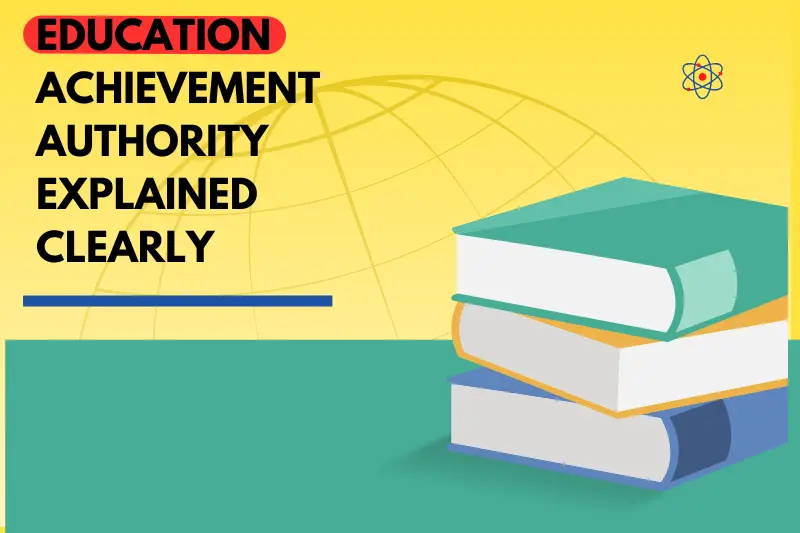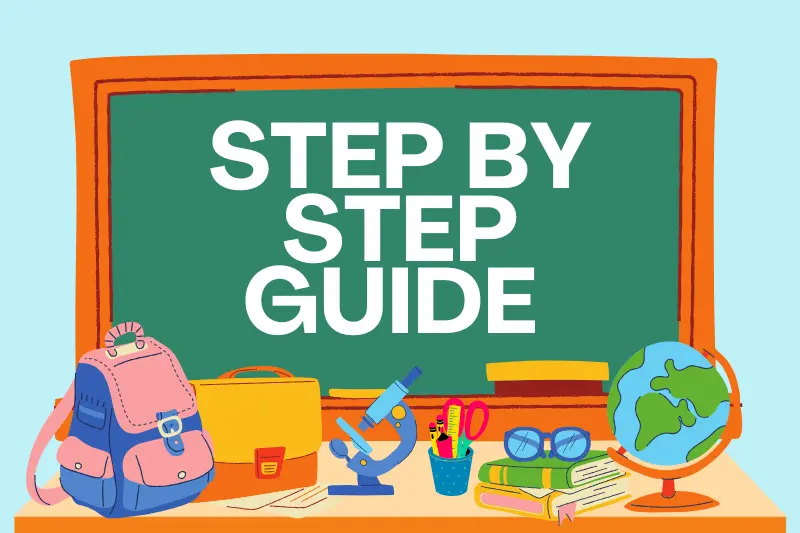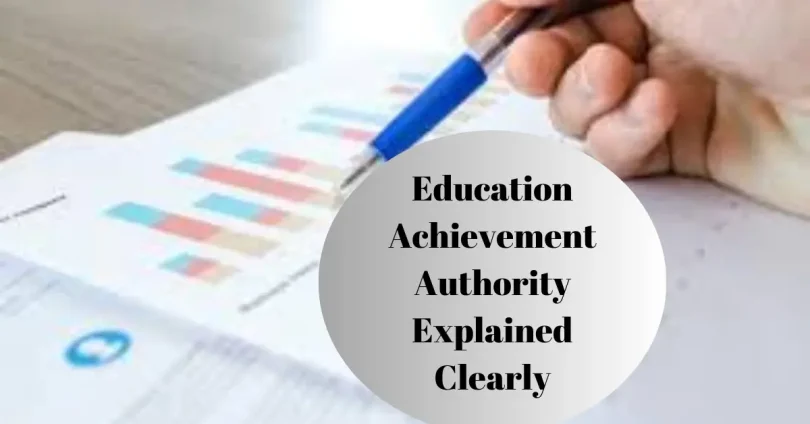Introduction
The Education Achievement Authority is a term that has drawn attention in recent years in the world of education. Whether you are a parent, teacher, or student, understanding this concept can help you stay informed about ongoing reforms and policies. With the constant changes in the education sector, especially in the United States, the role of specialized authorities is becoming more important than ever. One such body is the Education Achievement Authority, which was developed to bring better learning outcomes to struggling schools.
The aim is simple—to make sure that no student is left behind. Whether it is through new teaching strategies, curriculum updates, or the integration of tech & education, the Education Achievement Authority has taken on the challenge of improving school performance. When reading educational news, you might often come across this term, especially when discussing school reforms or turnaround efforts. It has become a central theme in conversations about public education quality and performance..
What Is Education Achievement Authority ?

It is a state level education agency or system created to manage and reform underperforming public schools. Its main job is to take control of failing schools and implement new strategies to turn them around. The goal is to improve student performance, increase graduation rates, and ensure that students in struggling areas receive a fair chance at quality education.
- The idea behind the Education Achievement Authority is that when local school districts are unable to provide the necessary results, an external system steps in to create positive change. This authority is usually granted power by the state government, and it often works with special funding, new policies, and expert leadership teams.
- It does not aim to replace traditional schools but rather to provide a temporary structure of support. Once schools show signs of progress, they are often returned to their original school districts with improved systems and practices in place.
Why Is Education Achievement Authority Important ?
It plays a critical role in the educational ecosystem. It provides a lifeline to schools that have consistently underperformed and failed to meet student needs. Below are key reasons why the Education Achievement Authority is considered important.
Provides Immediate Intervention
- It can respond quickly when schools are failing. It does not wait for years of poor results before taking action, which is often what traditional systems do.
Targets the Root of the Problem
- Instead of treating surface level issues, the Education Achievement Authority digs deep to identify what’s really causing low performance—whether it’s poor leadership, outdated teaching strategies, or lack of resources.
Uses Innovation in Learning
- One of the strengths of the Education Achievement Authority is its focus on innovation. It often uses modern methods, integrates tech & education, and introduces programs that help students learn in more engaging ways.
Improves Equity in Education
- Many schools taken over by the Education Achievement Authority serve low income communities. By focusing on these schools, the authority ensures that all students have access to high quality education, no matter their background.
Builds Better School Systems
- Through careful monitoring and support, the Education Achievement Authority helps build school systems that can continue to succeed even after the authority steps back.
Encourages Accountability
- Schools under the Education Achievement Authority are often held to higher standards. This pushes teachers, principals, and staff to perform better and focus on results.
Empowers Teachers and Leaders
- The Education Achievement Authority invests in training programs and leadership development. Teachers and school leaders gain new tools and strategies that make them more effective in the classroom.
Monitors Progress
- With a strong system for tracking progress, the Education Achievement Authority ensures that every reform is measured, and changes are made as needed to keep schools on the path to success.
Collaborates with Communities
- It often works closely with local communities to understand their needs and include them in the reform process.
Boosts Student Confidence
- When students see improvements in their schools, they feel more motivated to learn. This positive environment can change their entire educational journey.
Advantages Of Education And Disadvantages
| More Opportunities For Students It can open new doors for students by offering them better learning tools, updated classrooms, and dedicated support systems. |
| Personalized Learning Paths Students under the Education Achievement Authority are often given learning plans that match their unique needs, helping them achieve better outcomes. |
| Preparation For Real Life It focuses on teaching skills that are useful in real life, not just in school. This includes teamwork, time management, and digital literacy. |
| Increased Parent Involvement When schools are improving, parents become more involved. The Education Achievement Authority encourages family participation and builds stronger school communities. |
| Boost In Confidence And Performance With improved systems, students often feel more confident, which leads to better test scores and graduation rates. |
| Integration Of Technology Through partnerships and programs, the Education Achievement Authority often brings in modern tech solutions that make learning more interactive and flexible. |
| Better Use Of Resources By tracking performance closely, the Education Achievement Authority helps schools spend money wisely and focus on what works. |
| More Focused Goals With the Education Achievement Authority, schools work toward clear, measurable goals. Everyone knows what success looks like and how to reach it. |
| Stronger Teacher Support It provides training and support for teachers. This makes them more confident and effective in their teaching roles. |
| Improved School Environments Schools managed by the Education Achievement Authority often benefit from clean, safe, and wellmaintained facilities. This creates a space where students can focus on learning. |
Disadvantages
| Policy Changes Over Time The effectiveness of the Education Achievement Authority depends on government support, which can change with new political leadership. |
| Mixed Results Not all schools under the Education Achievement Authority improve, and outcomes can vary depending on the strategy used. |
| Lack Of Local Input When decisions come from the top, community voices might be overlooked in schools managed by the Education Achievement Authority. |
| Pressure On Performance There can be intense pressure to improve test scores quickly, which might take attention away from broader learning goals. |
| Limited Flexibility Schools under the Education Achievement Authority sometimes face strict rules, which can limit creativity or flexibility in teaching. |
| Funding Concerns There can be questions about how the Education Achievement Authority uses its budget and whether it receives enough funding to be effective. |
| Teacher Turnover In some cases, teachers leave when a school transitions to the Education Achievement Authority, leading to instability. |
| Uncertain Long Term Outcomes Some critics argue that the Education Achievement Authority offers only short term fixes and may not lead to lasting change. |
| Resistance From Communities Not everyone supports the Education Achievement Authority, especially when it replaces local leadership with external control. |
| Short Term Disruption Switching management to the Education Achievement Authority can cause confusion and disruption for staff and students in the beginning. |
A Step By Step Guide To Education Achievement Authority

Here is a simple step b ystep guide to understanding how the Education Achievement Authority works and what you can expect from it.
Identify Underperforming Schools
The state reviews school performance and identifies those consistently failing to meet educational standards.
Transfer School Management
Once selected, these schools are removed from their local district’s control and placed under the Education Achievement Authority.
Develop A School Improvement Plan
Experts create a plan that includes new goals, teaching methods, and resource management strategies for the school.
Recruit Qualified Leaders
It appoints strong principals and staff who are committed to turning the school around.
Train Teachers And Staff
Comprehensive training is provided to help teachers adapt to new methods, including tech & education integration.
Engage The Community
Parents, students, and community members are invited to participate and give feedback during the transformation process.
Introduce New Curriculum
The curriculum is updated to meet current educational needs, with a focus on realworld skills and interactive learning.
Monitor Progress Continuously
Data is collected and analyzed regularly to ensure goals are being met and necessary changes are made.
Provide Ongoing Support
It continues to support the school with funding, coaching, and resources.
Return School To Local District
Once improvements are stable, the school is gradually returned to local control with ongoing oversight if needed.
Challenges And Their Solutions
Lack Of Community Trust
Many communities are hesitant when the Education Achievement Authority takes over a school. They may feel disconnected from decisions or fear loss of control.
Solution:
Engaging local parents, leaders, and teachers early in the process helps build trust. Hosting open meetings and clear communication can also improve acceptance.
Teacher Turnover
When schools transition to the Education Achievement Authority, experienced teachers sometimes leave due to uncertainty.
Solution:
Providing professional development, job security, and involvement in decisionmaking encourages teachers to stay and support the mission.
Inconsistent Results
Not every school under the Education Achievement Authority improves at the same pace. Some may still struggle.
Solution:
Customizing strategies for each school, rather than using one model for all, helps address unique challenges and improves outcomes.
Limited Funding
It needs strong financial support, but funding is not always consistent or enough.
Solution:
Seeking partnerships with private organizations, tech companies, and local donors can help meet budget needs.
Political Changes
Since It is a state led program, political shifts can impact its policies or existence.
Solution:
Building bipartisan support and showing clear success stories helps maintain continuity despite political transitions.
Pressure For Quick Results
There is often pressure to show fast academic improvement, which can lead to shortcuts.
Solution:
Focusing on long term development, rather than short term test scores, leads to deeper and lasting improvement.
Technology Gaps
Not all schools under the it have equal access to digital tools.
Solution:
Ensuring every school receives proper funding for tech upgrades, internet access, and teacher training is essential.
Resistance To New Methods
Some educators may resist changes introduced by it, especially if they are used to old systems.
Solution:
Offering ongoing support, training, and clear explanations for new strategies helps ease the transition.
Accountability Confusion
Parents may not know who is responsible for school decisions once the Education Achievement Authority takes over.
Solution:
Maintaining clear communication channels and transparent updates can clarify roles and responsibilities.
Cultural Disconnect
Some reform models may not align with the cultural needs of the student population.
Solution:
Including diverse voices in planning and respecting local culture ensures better acceptance and effectiveness.
Future Of Education Achievement Authority
- The future of the Education Achievement Authority depends on how well it adapts to changing educational needs and continues to show positive results. As more schools explore ways to improve student performance, the demand for structured reform programs like this one may grow.
- It is likely to expand its focus beyond traditional classroom strategies. With the rise of tech & education, we can expect it to implement more digital tools, virtual learning options, and AI supported resources. This will make learning more accessible and personalized for students.
- Another key future trend is the integration of social and emotional learning. It may begin to focus not just on academics but also on student wellbeing, confidence, and life readiness.
- As public demand for transparency grows, It will need to keep improving its communication with communities, parents, and teachers. Open data, clear goals, and visible progress will shape its reputation and effectiveness.
Frequently Asked Questions (FAQs)
What is the main goal of the Education Achievement Authority?
The main goal is to improve performance in struggling public schools by providing special support, resources, and leadership.
Does the Education Achievement Authority replace local school boards?
Yes, it temporarily takes control from local school districts to manage and reform underperforming schools.
How long does the Education Achievement Authority stay in control of a school?
It usually manages a school until measurable progress is achieved, then transitions it back to the original district.
Can teachers remain at schools under the Education Achievement Authority?
Yes, many teachers continue working but may receive additional training and support to meet new expectations.
What kind of schools does the Education Achievement Authority manage?
It focuses on schools that have consistently shown low academic performance or failed to meet state standards.
Does the Education Achievement Authority use modern technology?
Yes, it often integrates tech & education tools to enhance learning and improve student engagement.
Is there community involvement in Education Achievement Authority schools?
Community input is encouraged, and efforts are made to involve parents and local leaders in school decisions.
Are students forced to attend Education Achievement Authority schools?
Students already enrolled in these schools usually remain, but the focus is on improving their current learning environment.
How is the Education Achievement Authority funded?
It receives funding from state education budgets, and sometimes through federal programs and private partnerships.
What happens if the Education Achievement Authority fails to improve a school?
If no improvement is seen, other interventions or leadership changes may be considered, depending on the state’s policies.
Conclusion
The Education Achievement Authority plays an important role in transforming schools that need the most help. With its focus on reform, innovation, and community support, it provides a fresh chance for students to succeed. While there are challenges, the authority continues to evolve and find better ways to deliver quality education. Staying informed about such programs through educational news helps us understand how our school systems can grow and improve. Whether you’re a parent, teacher, or student, knowing about the Education Achievement Authority helps you stay connected to the future of learning.
Ten Bonus Tips For Understanding Education Achievement Authority
Learn About Local Policies
Understand how your state applies the Education Achievement Authority model.
Attend School Meetings
Get involved in meetings to learn how schools are managed under the program.
Follow Educational News
Stay updated through educational news to see how the authority is performing.
Talk To Teachers
Ask teachers how the Education Achievement Authority has changed their classrooms.
Support Community Involvement
Help encourage community voices in decision making processes.
Watch For Technology Upgrades
Look for new tech tools in your school brought by the Education Achievement Authority.
Ask About Curriculum Changes
Check if subjects are being updated to match modern education needs.
Track School Results
Follow school performance reports to see if improvements are happening.
Support Professional Development
Encourage teacher training programs offered by the Education Achievement Authority.
Stay Patient With Progress
Understand that change takes time and support longterm improvement plans.







